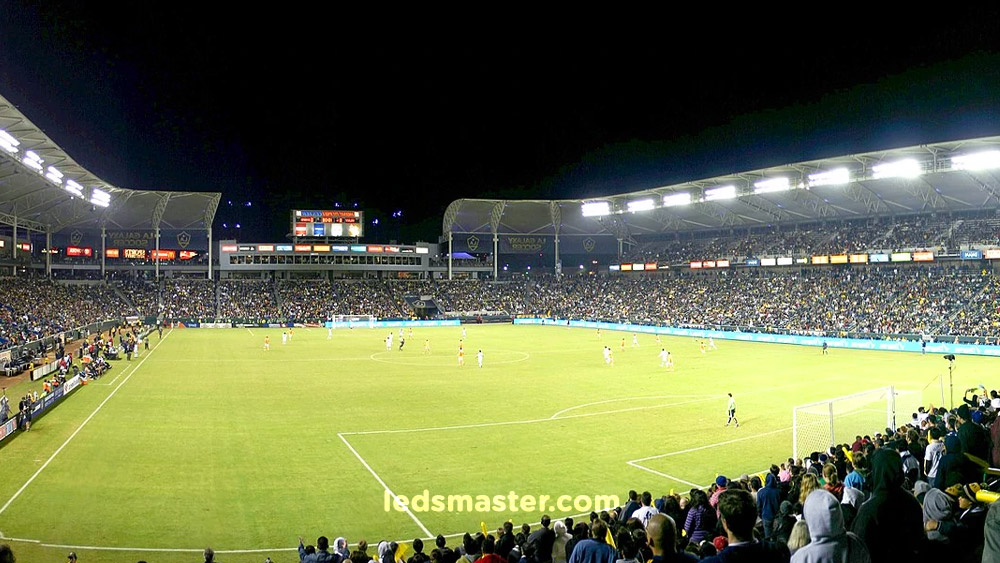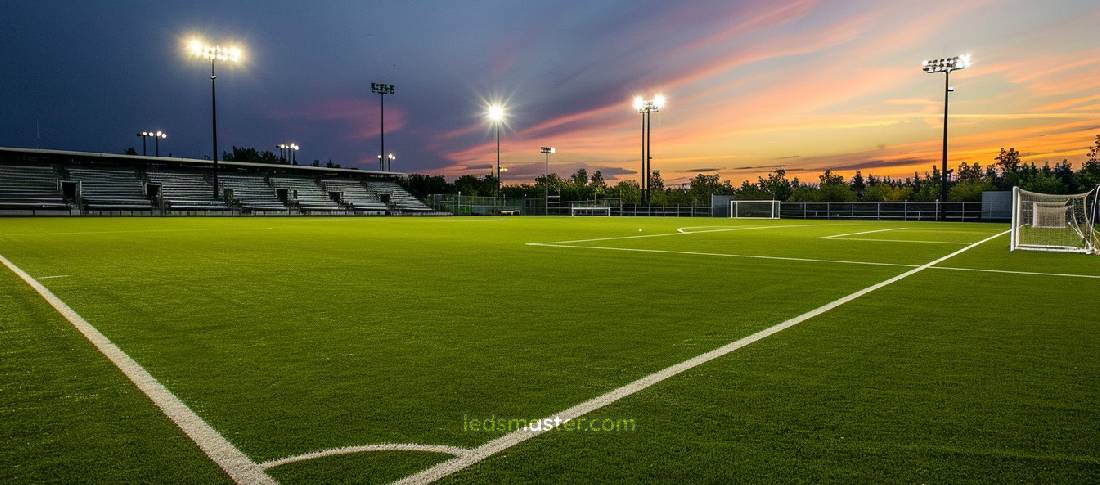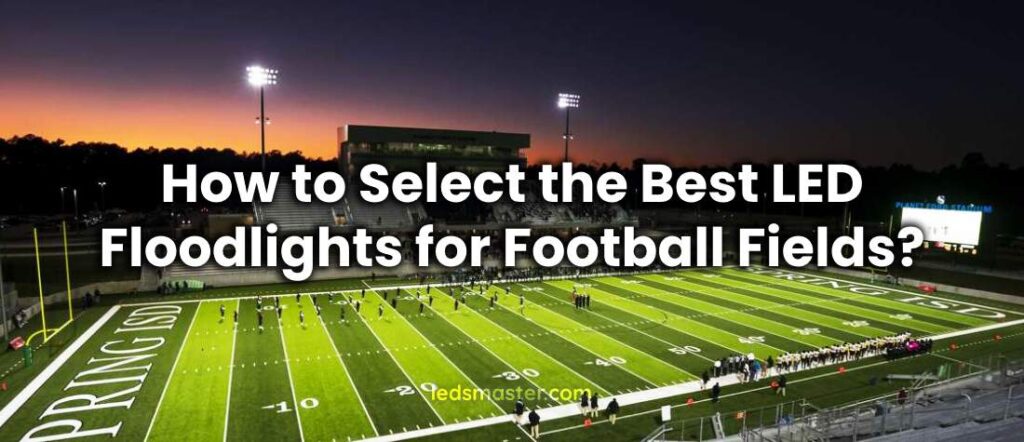Table of Contents
ToggleIntroduction
Choosing the right floodlight for a football stadium is a challenging task that requires careful consideration of several key factors. The power of the lights determines their brightness and coverage area, ensuring adequate illumination across the entire field. The color temperature affects the quality and clarity of the light, with options ranging from warm to cool tones. The beam angle is crucial for controlling the spread of light, ensuring it covers the field evenly without causing glare. Additionally, mounting brackets and other installation specifications are important to ensure the lights are securely and optimally positioned. Advances in LED technology have made LED stadium lights the preferred choice for both outdoor and indoor stadiums due to their energy efficiency, durability, and superior light quality. However, the widespread adoption of LED technology has led to a market saturated with millions of stadium lighting products, making it difficult to identify the best options.
Stadium lighting can be categorized into various types, including floodlights, which provide broad, powerful illumination; spotlights, which offer focused lighting for specific areas; high mast lights, installed on tall poles for large-scale illumination; and high bay lights, typically used in indoor arenas with high ceilings. Lighting technologies such as HID (high-intensity discharge), LED (light-emitting diode), and metal halide each have distinct characteristics and benefits. For newcomers to the lighting industry, these terms and classifications can be overwhelming. However, understanding these basic concepts is not difficult. This article aims to demystify the selection process and guide you in choosing the best lighting for your football field or other sports fields, ensuring an enhanced experience for both players and spectators.
How to Select the Best Football Field Lights and Stadium Floodlights?
Energy Efficiency of Stadium Lighting

LEDs are significantly more energy efficient than traditional metal halide and mercury vapor lighting fixtures, being 2 to 3 times more efficient. This means that a 400W LED can replace a 1000W metal halide or even a 1500W mercury vapor stadium light, resulting in up to 75% energy savings after retrofitting. This level of efficiency not only reduces electricity consumption but also lowers overall operating costs. While the energy savings from replacing a single lamp might not be very noticeable, the impact becomes substantial on a larger scale. For example, in a stadium equipped with 500 or more lamps, the cumulative energy savings are immense, significantly reducing the stadium’s carbon footprint and energy expenses.
To maximize energy efficiency with LED stadium floodlights, it is crucial to select fixtures that offer more than 160 lumens per watt. This high lumen-to-watt ratio ensures that the lights are providing maximum brightness while consuming minimal power. By achieving such efficiency, you can ensure potential energy savings of 75% to 85% when replacing traditional HID lights in stadium lighting. This not only translates to lower energy bills but also contributes to longer-lasting lighting solutions, as LEDs typically have a longer lifespan compared to metal halide and mercury vapor lamps. This results in reduced maintenance and replacement costs, further enhancing the economic benefits of switching to LED lighting systems for stadiums.
Warm-Up Time for Football Field Lights
Traditional HID (High-Intensity Discharge) and metal halide lights require a warm-up and cool-down period of 10 to 20 minutes. Each time the stadium lights are turned on or off, this lengthy wait can be inconvenient and unprofessional, particularly during sports events and training sessions where precise timing is crucial. This delay can disrupt schedules, cause frustration, and lead to inefficiencies in stadium operations. Moreover, the repeated cycling of these lights can reduce their lifespan and increase maintenance costs due to the need for frequent replacements.
Replacing HID lights with LED stadium lighting can effectively solve this problem. Unlike traditional HID lights, LEDs can be turned on instantly, reaching 100% brightness in less than a second. This immediate illumination is especially beneficial for quickly turning lights on and off between football games or other sports training sessions, ensuring seamless transitions and minimal interruptions. The ability to instantly achieve full brightness also enhances safety, as there is no period of partial illumination that could compromise visibility. Additionally, the reduced warm-up time translates to lower power costs since LEDs do not require the prolonged energy consumption associated with warming up and cooling down. This instant-on capability, combined with energy efficiency, makes LED stadium lights a superior choice for modern sports facilities, providing both operational convenience and cost savings.
Lifespan of the Chosen Sports Lights

When selecting stadium lights, considering their lifespan is paramount for ensuring long-term efficiency and cost-effectiveness. High-quality stadium lights should be chosen based on their ability to endure extensive use without frequent maintenance or replacement needs. For example, LED stadium lights are designed to last over 150,000 hours, significantly outlasting traditional HID lights. In contrast, HID lamps such as metal halide and halogen typically have a lifespan of only 10,000 to 20,000 hours, requiring frequent replacements due to their shorter durability and higher failure rates over time. Choosing LED floodlights with a lifespan ranging from 80,000 to 120,000 hours ensures reliability and reduces operational costs associated with maintenance and lamp replacement. This extended lifespan not only promotes the sustainability of sports venues but also ensures consistent lighting performance throughout the stadium lights’ lifespan, providing reliable illumination for athletes and spectators alike.
Wide Range of Stadium Light Beam Angles
A reputable stadium lighting supplier understands the importance of offering a diverse range of beam angles for their football lights. This variety is crucial because it allows for precise customization of lighting solutions tailored to the specific dimensions and layout of different sports fields. Football and soccer fields vary significantly in size and shape, and utilizing different beam angles ensures that lighting can be optimized to achieve uniformity and optimal visibility across the entire playing area. By strategically placing lights with appropriate beam angles, shadows can be minimized, and the entire field can be evenly illuminated, enhancing both the player experience and spectator enjoyment.
For example, our stadium lights are available in a wide array of beam angles, including 10 degrees, 15 degrees, 20 degrees, 25 degrees, 40 degrees, 60 degrees, 90 degrees, and 120 degrees. This extensive selection enables us to create customized lighting designs that meet the specific requirements of each unique field configuration. Whether it’s a small community sports ground or a large professional stadium, our adaptable lighting solutions ensure that every area of the field receives adequate and uniform illumination, enhancing visibility and safety during games and events.
CRI of Stadium Lighting Fixtures
The Color Rendering Index (CRI) stands as a pivotal consideration in stadium lighting fixtures due to its direct impact on color accuracy and visibility. CRI measures how faithfully a light source renders colors compared to natural sunlight, which is crucial for providing clear visibility and enhancing the visual experience during events held in stadiums. For football fields, high CRI stadium lights are particularly essential as they ensure that the colors of the field itself, as well as the players’ uniforms and stadium infrastructure, are perceived with utmost clarity and accuracy.
The presence of high CRI in stadium lights guarantees that football players can distinguish between different elements on the field accurately, aiding in performance and safety. Spectators benefit from a more vibrant and immersive experience, as the high CRI level enhances the vividness and realism of colors. Broadcast cameras also capture the action with greater fidelity, ensuring that televised or streamed games maintain high visual quality. Ultimately, the incorporation of high CRI stadium lights creates an environment where sports enthusiasts and viewers alike can enjoy an enhanced and true-to-life spectacle, fostering a deeper engagement with the game and its surroundings.
Intelligent Stadium Lighting Control
Modern stadium lighting systems rely heavily on intelligent control capabilities to achieve ideal lighting conditions tailored to a wide range of events and activities. The capability to adjust stadium lights collectively or individually is essential for accommodating diverse lighting needs during sports games, concerts, or other stadium events. These systems support integration with DMX, DALI, and 0 to 10V dimming systems, facilitating smooth operation within different stadium setups and lighting arrangements. This versatility ensures that lighting can be precisely adjusted to enhance visibility and atmosphere, making intelligent control a fundamental aspect of contemporary stadium lighting solutions.
These advanced control options empower operators to wirelessly manage stadium lights from a centralized control panel, PC, iPad, or smartphone. This flexibility allows for effortless adjustments of brightness levels and lighting patterns, ensuring precise illumination that enhances visibility and ambiance as needed. By dynamically controlling the lights based on real-time demands, intelligent systems not only optimize operational efficiency but also contribute to significant energy savings. This capability ensures that stadiums can maximize lighting performance while minimizing unnecessary energy consumption, making intelligent control a cornerstone of modern stadium lighting solutions.
Conclusion
Choosing the right floodlights for a football stadium involves careful consideration of various factors such as power, color temperature, beam angle, and installation specifications. LED technology has emerged as the preferred choice for stadium lighting due to its energy efficiency, durability, and superior light quality. Despite the abundance of options in the market, understanding the distinctions between floodlights, spotlights, and different lighting technologies like HID and LED is crucial for making informed decisions. High-efficiency LED floodlights can significantly reduce energy consumption and operational costs while offering instant illumination and long-term reliability. Additionally, features like intelligent control systems further enhance flexibility and energy savings, ensuring stadiums can maintain optimal lighting conditions tailored to different events.

